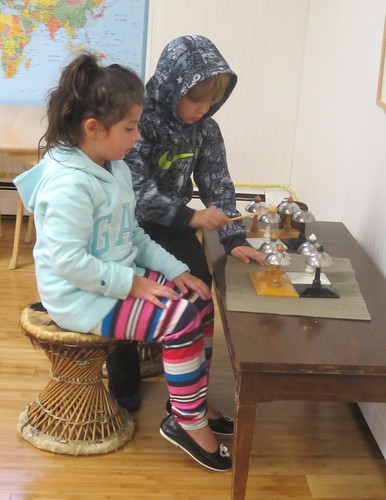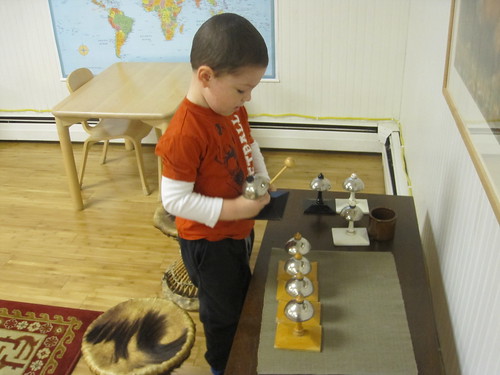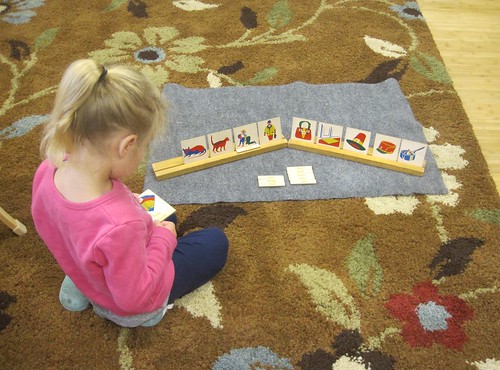 Fall has arrived! The leaves are turning and the weather is cooling off so our wardrobes now include sweatshirts, sweaters, jackets and long sleeves.
Fall has arrived! The leaves are turning and the weather is cooling off so our wardrobes now include sweatshirts, sweaters, jackets and long sleeves. 




 For art on Monday the children were introduced to Yves Klein and his signature color blue. We read the story, A Blue So Blue about a little boy who dreams of a shade of blue both soft and strong and he searches the world far and wide to find it, finally returning home to his mother and her eyes that are the color he has been dreaming of. We learned about monochrome art – pictures that are done in various shades of one color – then made our own blue art.
For art on Monday the children were introduced to Yves Klein and his signature color blue. We read the story, A Blue So Blue about a little boy who dreams of a shade of blue both soft and strong and he searches the world far and wide to find it, finally returning home to his mother and her eyes that are the color he has been dreaming of. We learned about monochrome art – pictures that are done in various shades of one color – then made our own blue art. 
 The play dough was very popular this week, as it was night sky blue with sparkling silver “stars” and was paired with a variety of nocturnal animals. We discussed the difference between nocturnal, being awake at night, and diurnal, being awake during the day. Most animals, including humans, are diurnal, but some animals are nocturnal. Ask your child if he/she can recall some of the nocturnal animals that were with the play dough. Some may surprise you!
The play dough was very popular this week, as it was night sky blue with sparkling silver “stars” and was paired with a variety of nocturnal animals. We discussed the difference between nocturnal, being awake at night, and diurnal, being awake during the day. Most animals, including humans, are diurnal, but some animals are nocturnal. Ask your child if he/she can recall some of the nocturnal animals that were with the play dough. Some may surprise you!  The bell matching has also been popular. There are currently four pairs to match, though we will eventually build up to the full set of thirteen pairs. Each black or white base bell matches one brown base bell. The children tap them gently to hear the tone, then listen carefully to hear which ones sound the same. It is a challenging auditory discrimination activity!
The bell matching has also been popular. There are currently four pairs to match, though we will eventually build up to the full set of thirteen pairs. Each black or white base bell matches one brown base bell. The children tap them gently to hear the tone, then listen carefully to hear which ones sound the same. It is a challenging auditory discrimination activity! 


 We talked a bit about gardens and which vegetables we grew in our gardens this summer. We discussed the harvest season when we pick everything that is left before the weather turns too cold and the frost kills it all. We read the story Tops and Bottoms about a hare who convinces a lazy bear to let him plant vegetables on his land, and in exchange he will do all of the work and share the harvest with bear. When the bear chose to have the tops, hare planted beets, carrots, and radishes. When bear chose the bottoms, hare planted celery, lettuce, and broccoli, and when bear asked for both tops and bottoms, hare planted corn. The following year, and every year after, bear stops being lazy and plants and harvests his own crops.
We talked a bit about gardens and which vegetables we grew in our gardens this summer. We discussed the harvest season when we pick everything that is left before the weather turns too cold and the frost kills it all. We read the story Tops and Bottoms about a hare who convinces a lazy bear to let him plant vegetables on his land, and in exchange he will do all of the work and share the harvest with bear. When the bear chose to have the tops, hare planted beets, carrots, and radishes. When bear chose the bottoms, hare planted celery, lettuce, and broccoli, and when bear asked for both tops and bottoms, hare planted corn. The following year, and every year after, bear stops being lazy and plants and harvests his own crops. We were introduced to the seasons, particularly fall, and why they change. We read part of the book, Sunshine Makes the Seasons, which told us how the sun warms the earth. When the days get shorter, the weather gets colder because the sun does not shine as long. We looked at the globe and saw how the sun is tilted and that it takes one year to go around the sun. As it orbits the sun, we get less or more sunlight depending on where we are in the earths’ orbit and whether we are tilted toward the sun or away. We used a flashlight shining on the globe to demonstrate this rather complex concept. Although it is a lot to grasp, our song, “Four Seasons Every Year” helps us to remember that the seasons are due to the tilt of the earth. We have kept an eye on our handwashing experiment, and we have spotted some germs growing on the bread touched by all of the dirty hands, and the bread touched by the rinsed hands, but the control piece and the handwashing piece are both germ free.
We were introduced to the seasons, particularly fall, and why they change. We read part of the book, Sunshine Makes the Seasons, which told us how the sun warms the earth. When the days get shorter, the weather gets colder because the sun does not shine as long. We looked at the globe and saw how the sun is tilted and that it takes one year to go around the sun. As it orbits the sun, we get less or more sunlight depending on where we are in the earths’ orbit and whether we are tilted toward the sun or away. We used a flashlight shining on the globe to demonstrate this rather complex concept. Although it is a lot to grasp, our song, “Four Seasons Every Year” helps us to remember that the seasons are due to the tilt of the earth. We have kept an eye on our handwashing experiment, and we have spotted some germs growing on the bread touched by all of the dirty hands, and the bread touched by the rinsed hands, but the control piece and the handwashing piece are both germ free. 





























 Thursday was the harvest festival. The children participated in a variety of art activities and games, including vegetable printing, pine cone rolling art, leaf painting, sack races, watermelon bowling, bean bag toss, and an apple grabbing game (moving apples floating in water from one bucket to another using tongs). Many families joined us for the fun and while some children made a few choices and moved on, others did everything available. We had a surprise visit from Sue, one of our teachers from last year. The children were very excited to see her and had a great time wrestling and horsing around with her. It was a fun morning!
Thursday was the harvest festival. The children participated in a variety of art activities and games, including vegetable printing, pine cone rolling art, leaf painting, sack races, watermelon bowling, bean bag toss, and an apple grabbing game (moving apples floating in water from one bucket to another using tongs). Many families joined us for the fun and while some children made a few choices and moved on, others did everything available. We had a surprise visit from Sue, one of our teachers from last year. The children were very excited to see her and had a great time wrestling and horsing around with her. It was a fun morning! 










 Friday students continued the fall harvest theme with an apple taste test for science. We read I Am an Apple about the life cycle of an apple, then we all washed our hands to begin the taste test. We examined 7 varieties of apple: granny smith, golden delicious, gala, mac, honeycrisp, fuji, and red delicious. We noticed that they all looked different on the outside. They had different shapes and different coloring. When we cut them open we observed that they looked a little different on the inside as well. When we tasted them we noticed that they all tasted differently. Some were tart, others were sweet. Some were hard and crispy, while others were soft and mushy. Everyone decided which ones were their favorites and wrote their names on the chart next to the type they preferred. The Golden Delicious was the most popular by far!
Friday students continued the fall harvest theme with an apple taste test for science. We read I Am an Apple about the life cycle of an apple, then we all washed our hands to begin the taste test. We examined 7 varieties of apple: granny smith, golden delicious, gala, mac, honeycrisp, fuji, and red delicious. We noticed that they all looked different on the outside. They had different shapes and different coloring. When we cut them open we observed that they looked a little different on the inside as well. When we tasted them we noticed that they all tasted differently. Some were tart, others were sweet. Some were hard and crispy, while others were soft and mushy. Everyone decided which ones were their favorites and wrote their names on the chart next to the type they preferred. The Golden Delicious was the most popular by far!


 The stories we read this week:
The stories we read this week: 
A Blue So Blue by, Jean-FranCois Dumont
Fall by, Sian Smith & Rebecca Rissman
Sunshine Makes the Seasons by, Franklyn M. Branley
Tops and Bottoms by, Janet Stevens
The Big Red Barn by, Margaret Wise Brown
Red Riding Hood by, James Marshall
Animals Should Definitely Not Wear Clothing by, Judi Barret
Fall Leaves by, Loretta Holland & Elly MacKay
The Very Busy Spider by, Eric Carle
I Am an Apple by, Jean Marzollo